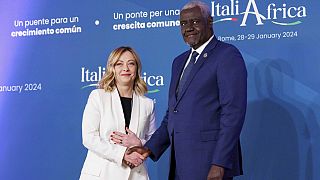
Latest News Regarding
Horn of Africa
Türkiye Signs Defense Deal with Somalia and Reiterates Support for Sovereignty
Türkiye Signs Defense Deal with Somalia and Reiterates Support for Sovereignty
Source: Al-Monitor published on 7 February 2024 an article titled “Turkey, Somalia Sign Defense Deal in Wake of Ethiopia-Somaliland Agreement” by Ezgi Akin.
Somalia and Türkiye signed this week an agreement on the fight against terrorism and military-financial cooperation. Türkiye reiterated its support for Somalia’s territorial integrity and sovereignty in the wake of Ethiopia’s willingness to consider the recognition of an independent Somaliland.
Al-Shabab claims attack in Somali capital that kills 3 Emirati troops and 1 Bahraini officer
Al-Shabab claims attack in Somali capital that kills 3 Emirati troops and 1 Bahraini officer

Source: AP, BY JON GAMBRELL
Sunday February 11, 2024
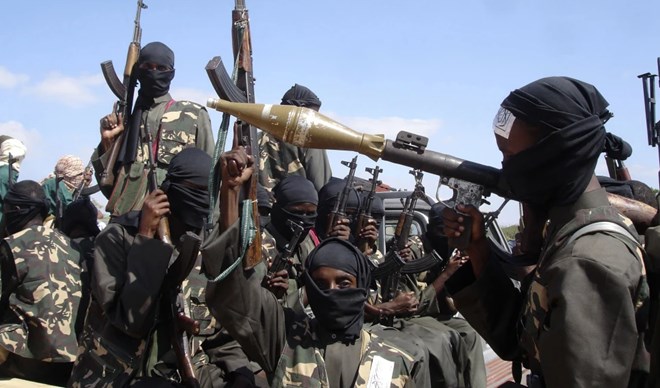
FILE – Armed al-Shabab fighters ride on pickup trucks as they prepare to travel into the city, just outside the capital Mogadishu, in Somalia on Dec. 8, 2008. The al-Qaida-linked militant group al-Shabab claimed an attack that killed three Emirati troops and a Bahraini military officer on a training mission at a military base in the Somali capital, authorities said Sunday, Feb. 11, 2024.(AP Photo/Farah Abdi Warsameh, File)
The al-Qaida-linked militant group al-Shabab claimed an attack that killed three Emirati troops and a Bahraini military officer on a training mission at a military base in the Somali capital, authorities said Sunday.
The attack Saturday targeted the troops at the General Gordon Military Base in Mogadishu. Details about the attack and whether it killed others remained scarce Sunday, though Somali President Hassan Sheikh Mohamud offered his condolences to the UAE for the loss of its troops in the assault.
Early Sunday, the UAE’s state-run WAM news agency reported the killing of three of its troops and the Bahraini soldier in a “terrorist act,” without elaborating. It added that the attack wounded two others. Bahrain, an island nation in the Persian Gulf off the coast of Saudi Arabia, did not immediately acknowledge the attack.
Al-Shabab claimed the attack in a statement online, alleging it killed multiple people involved in the Emirati military effort. It described the UAE, a federation of seven sheikhdoms on the Arabian Peninsula, as an “enemy” of Islamic Shariah law for backing the Somali government in its efforts to battle al-Shabab.
Al-Shabab, or “the youth” in Arabic, is a Sunni Islamic extremist group in Somalia born out of that country’s years of anarchy following its 1991 civil war. The affiliate of al-Qaida once held Mogadishu. Over time, an African Union-led force, with the backing of the U.S. and other countries, pushed the militants out of Mogadishu. In the years since, al-Shabab has remained a militant threat in Somalia as it seeks to overthrow the Western-backed government there.
Al-Shabab has carried out attacks in neighboring Kenya as well, since Nairobi provides troops and materiel to the African Union force in the country.
Somalia has also been an intense interest for Gulf states, particularly the Qatar diplomatic crisis that gripped the region for several years and saw four nations including the UAE boycott Doha in a political dispute. Somali troops once seized millions of dollars of Emirati cash from a jet at gunpoint, sparking a diplomatic incident between Mogadishu and the UAE that halted its troop training program there.
The UAE in recent years has increasingly invested in ports in East Africa, including in Somalia’s breakaway Somaliland region. Securing Somalia fits into the Emirates’ wider concerns about security in the Gulf of Aden and the Arabian Sea, particularly as Somali piracy has resumed after years amid attacks by Yemen’s Houthi rebels on shipping in the region over Israel’s war on Hamas in the Gaza Strip.
In 2019, al-Shabab claimed an attack that killed a man working for Dubai’s P&O Ports.
UPDATE: Al-Shabab attack on Mogadishu’s General Gordon camp kills UAE colonel, Bahraini officer
UPDATE: Al-Shabab attack on Mogadishu’s General Gordon camp kills UAE colonel, Bahraini officer

Source: Hiiraan Online, Sunday February 11, 2024
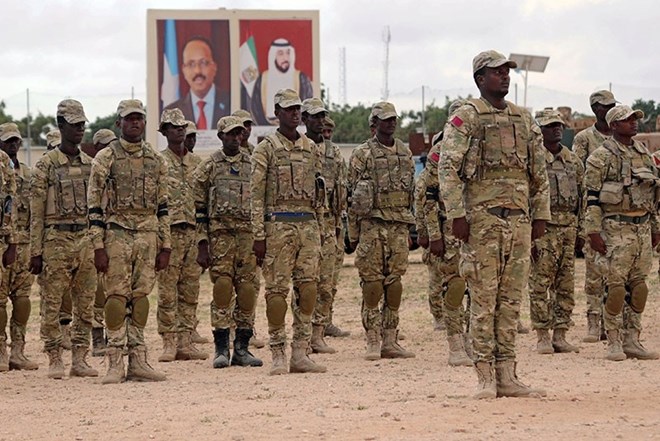
FILE – Somali military officers attend a training program by the United Arab Emirates (UAE) at their military base in Mogadishu, Somalia November 1, 2017. (Reuters Photo)
Mogadishu (HOL) – An attack at the General Gordon Military Base in Mogadishu claimed the lives of three Emirati soldiers and a Bahraini officer. Authorities revealed that the attack, described as a terrorist act, targeted the military personnel involved in a mission to train local forces.
The United Arab Emirates Defense Ministry confirmed that their personnel were among the casualties, along with two injured. A senior officer from the United Arab Emirates Air Force, Colonel Muhammad Mubarak Al-Mansoori, head of the training mission, is reportedly among the deceased. While not officially affirmed by the Emirati authorities, Mubarak’s death was confirmed by Somali military and government sources.
According to medical personnel, both Somali and foreign officers and soldiers suffered injuries in the attack and were transported to various hospitals.
The Al-Shabaab gunman, a newly trained Somali soldier, was also shot dead at the Gordon military base managed by the UAE, according to Somali military officials. The attacker, previously on security detail at the camp, was reportedly known to be a recent defector from Al-Shabaab but was still recruited into the military, according to military sources.
The assault has drawn widespread condemnation and a swift promise of an investigation by Somali President Hassan Sheikh Mohamud. In an expression of solidarity and mourning, President Mohamud visited Digfeer Hospital, meeting with wounded UAE officers and grieving for the lives lost to what he described as a “sinful terrorist act.”

Left: An undated photo captures Colonel Muhammad Mubarak Al-Mansoori being awarded a medal by Sheikh Mohamed bin Zayed Al Nahyan, President of the United Arab Emirates and Ruler of Abu Dhabi, in recognition of his military service. Right: Another undated photo commemorates Colonel Al-Mansoori, who was killed in a recent Al-Shabab attack on the General Gordon Military Camp in Mogadishu.
Al-Shabab, an al-Qaida-linked militant group, claimed responsibility for the deadly attack. The group said it targeted the UAE for backing Somalia’s government in its counterinsurgency against the militant extremist group. They also claimed 17 officers from the UAE, Somalia, and other partner nations were killed; however, the group is known to exaggerate its casualty figures for propaganda purposes.
Somali President Hassan Sheikh Mohamud offered condolences and visited the wounded officers at Erdogan (formerly Digfeer) Hospital, expressing grief over the loss and condemning the attack.
“I condemn to the worst terms the incident that took the lives of the UAE officers who sacrificed their time and lives to liberate and rebuild our country,” Mohamud said.
The attack highlights the nature of military collaboration in Somalia, where Gulf states, particularly the UAE, play a role in counterterrorism and training efforts. In recent years, the UAE has also significantly invested in ports in Somalia’s breakaway Somaliland region by constructing the Berbera corridor through DP World.
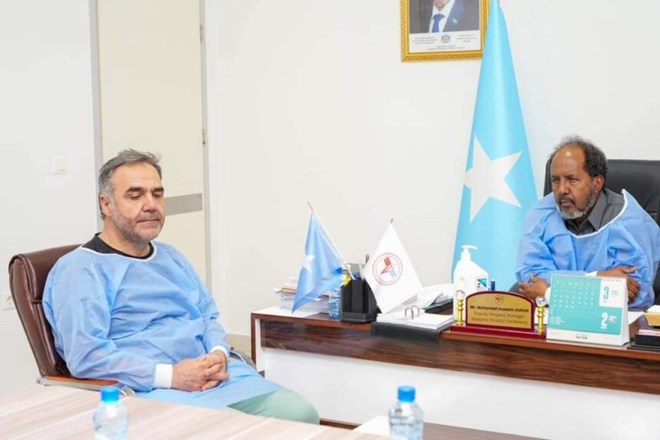
Somali President Hassan Sheikh Mohamud offers condolences and support during his visit to Erdogan Hospital in Mogadishu, where he met with Gulf officers wounded in an attack at General Gordon Camp on Monday, February 10, 2024. / SONNA
Uganda’s Judge Sebutinde takes over as ICJ vice-president
Uganda’s Judge Sebutinde takes over as ICJ vice-president

Source: BBC, Wednesday February 7, 2024

She was in the spotlight last month over the Gaza war case ruling
Ugandan-born Judge Julia Sebutinde has been elected vice-president of the International Court of Justice (ICJ) in Hague, Netherlands.
The judge recently caused controversy in the international community when she ruled against emergency measures requested by South Africa against Israel over the war in Gaza.
She was the only judge on the 17-member ICJ panel to vote against all six measures adopted by the ICJ court in a ruling ordering Israel to take action to prevent acts of genocide as it fights Hamas militants in the Gaza Strip.
Ms Sebutinde was one of only two judges who issued dissenting judgements while 15 voted for the emergency measures which covered most of what South Africa had asked for in the case.
The Ugandan government distanced itself from the judge’s dissenting opinion, saying it did not represent the East African country’s position in the conflict.
There were many critical comments on social media, with some wondering why she chose not to be more sympathetic to South Africa’s case.
The court announced on Tuesday that Ms Sebutinde was elected vice-president for three years, in what appears to be a major vote of confidence in her.
Lebanon-born judge Nawaf Salam takes over as ICJ judge-president from Joan Donoghue.
Ms Sebutinde has been an ICJ judge for more than a decade. She previously handled several high-profile war crime trials, including the prosecution of former Liberian President Charles Taylor.
Protests erupt in Somalia over ‘husbands killing wives’
Protests erupt in Somalia over ‘husbands killing wives’

Source: VOA, Wednesday February 7, 2024
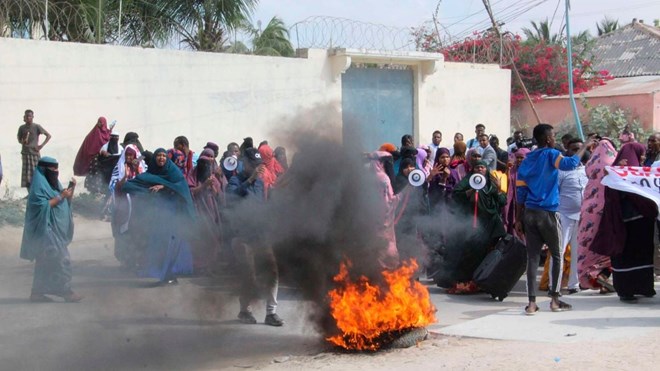
Three women were killed in Somalia last week in what police say were marriage disputes. The country’s parliament called for urgent investigations and the arrest of the perpetrators as citizens expressed outrage.
The killings occurred in Mogadishu, the Lower Shabelle region and the Qoryooley District. One woman was stabbed, a second shot and a third set on fire — all allegedly at the hands of their husbands.
The police chief of the Banadir region that includes Mogadishu, Moalim Mahdi, pledged to bring the offenders to justice.
Gender-based violence remains prevalent in Somalia. The situation is worsened by the absence of strong legal frameworks to deter attacks.
In 2020, parliament debated a controversial bill to address gender-based violence but was forced to hold it back following local and international pressure over clauses that allowed for child and forced marriage and other violations of women’s rights.
Amina Haji Elmi, director of the Mogadishu-based advocacy group Save Somali Women and Children, said, “Somali women, alongside others, have been living in the war-ravaged country. They were victimised by both natural disasters and man-caused problems.
Currently, women are facing many challenges; among them are lack of support and poverty. They do not get protection and support after incidents.”
Elmi called on security agencies to deliver justice to the families of those killed.
“We strongly condemn the heinous acts against these innocent women,” Elmi said. “It is sad to hear that a mother is being killed in front of her children. We call upon the security agencies to bring the perpetrators to justice. We extend condolences to the families of these victims.”
Members of parliament decried the killings during a debate Saturday and called for the offenders to be prosecuted.
Despite the condemnations, Somali lawmakers have yet to pass the UN-backed Sexual Offenses Bill that the Council of Ministers approved in 2018. Female MP Gobsan Muhumed was among those who spoke during the session.
“It is heartbreaking for paternal orphans to witness their mother being burned by their stepfather, who was laughing at the time of the incident,” she said.
On Sunday in the southwestern town of Afgooye, another man was arrested in possession of gasoline and a matchbox amid allegations he intended to set his wife and children on fire.
Prosecutors in Somalia rely on provisions of the 1970s penal code to charge perpetrators of sexual and other gender-related offenses. Critics say this law is not tough enough and have called for the government to adopt harsher penalties.
UK warns of risk of famine in Ethiopia
UK warns of risk of famine in Ethiopia

Source: BBC, By James Landale
Diplomatic correspondent, in Mekelle, Ethiopia
Monday February 5, 2024
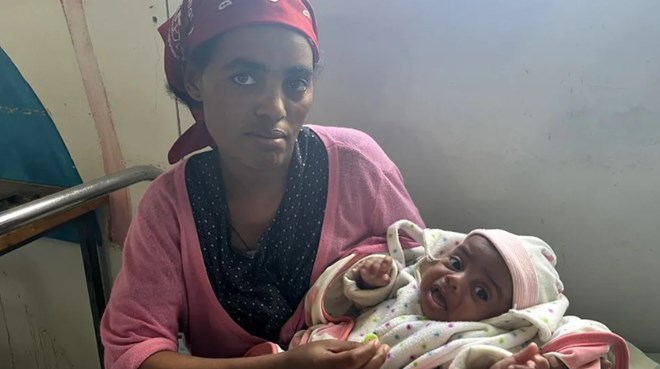
Tsega Tsigabu’s baby is one of the many suffering from malnutrition in Ethiopia’s Tigray region
In Ayder hospital in Mekelle, the capital of Ethiopia’s Tigray region, the corridors are filled with the hubbub of any busy medical facility. But in the paediatric wing, there is a stillness to the wards.
For here lie children numbly bearing witness to the latest food crisis to ravage northern Ethiopia. Mostly babies, they are suffering from severe acute malnutrition.
Their mothers sit silently at their beds, staring into the middle distance, clutching their infants to their breast, hoping what milk they have can deliver the salvation for which they yearn.
For they and Ethiopia are suffering once again from a devastating legacy of conflict and drought, twin evils that in recent years have destroyed farms and crops and forced millions from their homes.
The government says 16 million people across the country are facing food shortages, with almost half of those suffering emergency or severe levels of food insecurity. That means many are not just hungry, they are starving.
This is why Tsega Tsigabu, 23, and her four-month-old son, Kidisty, are languishing in Ayder hospital.
Her family were farmers. But their crops failed and they moved to Mekelle to try to survive. Like so many others, they ended up in a camp for people forced from their homes.
Tsega’s husband was in the army but he injured his hand and cannot work. She took her baby for a vaccination and the nurses saw instantly it was malnourished.
“Even when I was pregnant, I was not eating a balanced diet,” Tsega tells us. “I was not producing enough breast milk, that’s why the baby has developed malnutrition. I just didn’t have enough to eat at home.”
Doctors at the hospital tell us the numbers of severely malnourished children being admitted have doubled since 2020 when the war between Tigrayan forces and Ethiopian and Eritrean armies began.
A ceasefire was agreed in 2022 but the impact of the conflict still lingers with at least one million people still unable to return home remaining in the region.
We travelled with the British Africa minister, Andrew Mitchell, to Agulae, an hours’ drive north into the hills, where a clinic was assessing children from outlying villages.
He watched as anxious mothers lined up to have the circumference of their children’s arms measured; the less flesh on the bone, the more likely the malnutrition. The nurses showed him their charts and they all told a similar story of the numbers getting worse.
“There is clearly a risk of famine if we don’t now take action,” Mr Mitchell told the BBC.
“There are serious indicators of the danger of famine. If you ask me, ‘Is there a famine taking place now in Ethiopia?’ I say no, and we have the power to stop it. But if we don’t take the necessary action now, then there is every danger that a famine will engulf this war-torn country which has suffered so much already.”
He promised Britain would commit a further £100m to help up to three million mothers and babies in Ethiopia get access to health care; a new fund to provide medicines and vaccines designed to end preventable deaths.
But is famine in Ethiopia really likely?
International aid agencies are cautious about using what some call “the F- word”.
It has a precise technical definition – 20% of households facing extreme food shortages, 30% of children under five with acute malnutrition, and two people out of every 10,000 dying every day. Few suggest those criteria have been formally met in Ethiopia.
But for Getachew Reda, president of the Tigray interim regional administration, those definitions are otiose.
He told the BBC there was an “unfolding famine” in Tigray. The numbers of those “staring death in the eye” were rising all the time, he told us, criticising the international community for its “lacklustre” response.
“One thing I know is that thousands of people who would otherwise have been able to feed themselves are not in a position to feed themselves and are succumbing to death because of starvation,” Mr Getachew said.
“Whether you call it famine or a risk of famine or a potential famine, for me it’s purely academic… What transpired in 1985, for example, would pale into comparison, if we fail to address the kind of unfolding famine that’s staring us in the eye.”
What he was referring to were the devastating crises of the mid-1980s when many hundreds of thousands died in a famine in Tigray and elsewhere.
The BBC’s powerful reporting of the humanitarian disaster prompted a wave of publicity and campaigning, including the Live Aid concert led by the musician Bob Geldof.
These comparisons infuriate the federal government in Addis Ababa which denies there is famine.
Shiferaw Teklemariam, commissioner of the Ethiopian disaster risk management commission, said Ethiopia was a victim of climate change. He warned regional governments against politicising the issue and urged them and the international community to do more.
“There is a drought, no famine,” Mr Shiferaw told the BBC.
“The government is responding very seriously, but at the same time we call on all stakeholders to do their share.”
There are politics here.
Past famines in Ethiopia have sometimes been linked to the downfall of governments. Analysts say the word makes the current administration – led by Prime Minister Abiy Ahmed – nervous.
The government is working with the UN to tackle the food crisis but the economy here is weak and budgets are being cut.
The truth is that no-one really knows how bad this crisis is because hard data is difficult to obtain.
Media access is limited. Many areas in the north are impossible for humanitarian agencies to visit because of continuing fighting, especially in Amhara.
There, and in neighbouring Afar region, there are fears the food crisis could be even worse than in Tigray. Successive anecdotal evidence – reports from villages and towns across northern Ethiopia – suggest the situation is deteriorating.
What most sides agree is the international community should be doing more.
Last year USAID, America’s development agency, and the United Nation’s World Food Programme suspended humanitarian support for five months after it emerged that huge amounts were being stolen, much of it to feed various armed forces.
This has aggravated the situation. The world is also distracted by conflicts in the Middle East and Ukraine and less attention and funding is being targeted at Ethiopia.
The head of the UN here, Ramiz Alakbarov, said this was a forgotten crisis. “The world is not paying attention,” he said.
“We grieve for all the troubles and difficulties elsewhere, yet people in this part of the world cannot be forgotten. We need to get organised and donors need to step up contributions.”
At a food distribution centre in Mekelle, we saw the World Food Programme doing what it could, handing out scoops of wheat and lentils along with cups of oil.
The hungry queue up bearing QR codes which identify them, their households and their needs. But the food they get is a bare minimum and budgets are running thin.
Claire Nevill, who speaks for the WFP in Ethiopia, said what was needed was not just food assistance but help to get people back to their farms so they can feed themselves.
The problem is that parts of the country are still occupied by militias and Eritrean forces.
“In Ethiopia you have several overlapping crises at a time,” she said.
“We have drought, people recovering from a two-year conflict, rising inflation, an upsurge in cases of disease and all of this together just pushes people further into hunger and malnutrition. So if we don’t get food assistance to people right now, the situation will worsen.”
Back in Ayder hospital we met Tsige Degef, 28, whose 15-month old daughter, Bereket, was malnourished.
And her story was typical. Tsige’s extended family were forced to sell their oxen during the war to pay for expensive cereals. When peace came, the crops failed and there was nothing to fall back on.
Tsige was already struggling when Bereket fell ill. “Her feet and legs were swollen,” she said. “I was so worried. She was vomiting every day. The fear of a mother with a sick child is the fear of death.”
But Bereket is getting better and Tsige is hopeful of leaving hospital. “I wish she will heal soon,” she said.
“I want to open a tea shop and sell things so I can better protect my child. I promise to do the best I can so that she doesn’t suffer in the future.”
Sudan: Inability to Move Food Is Resulting in Starvation
Sudan: Inability to Move Food Is Resulting in Starvation
Source: Aljazeera published on 2 February 2024 an article titled “People ‘Dying of Starvation’ in Sudan, UN Food Agency Says.”
Nearly 18 million Sudanese are facing acute hunger and life-saving assistance is not reaching those who need it most. Humanitarian aid personnel are not able to get appropriate cooperation from the paramilitary Rapid Support Forces and the Sudan Armed Forces to deliver food.
The murder of Somali wives by their husbands in Somalia is unacceptable
Source: Somalia International Rehabilitation Centre (SIRC): The killings of Somali women in recent years by their husbands in Somalia have been extremely shocking and unacceptable. The Somali state institutions and Somali people as a whole should take immediate action against these barbaric ugly actions which damage the name of Somalia and Somali people where ever they live.
Man arrested for stabbing wife to death in Qoryooley
Source: Hiiraan Online, Man arrested for stabbing wife to death in Qoryooley

Saturday February 3, 2024

Mogadishu (HOL) – Security forces in the Qoryooley district of Somalia’s Lower Shabelle region have detained a man accused of stabbing his wife to death. The incident, which occurred yesterday afternoon, is under investigation to determine the motive behind the fatal stabbing, which reportedly stemmed from a family dispute.
advertisementsAccording to reports, the assailant employed a sharp knife to inflict multiple critical injuries on his spouse. Local authorities acted promptly, capturing the suspect before he could flee.
This latest incident is part of a concerning trend of increased domestic violence in Somalia, coming a day after the murder of a pregnant mother in Mogadishu. The mother, who was caring for six orphaned children, succumbed to injuries from a fire set by her jealous husband.
Call for justice after pregnant mother of six murdered by husband in Mogadishu
Call for justice after pregnant mother of six murdered by husband in Mogadishu, Somalia

Source: Hiiraan Online, Mogadishu (HOL) – In a horrifying incident on Friday morning in Mogadishu, Luul Abdiaziz, a pregnant woman and airport worker, died from injuries after her husband allegedly set her on fire. The tragedy, rooted in what reports suggest may be jealousy, has sparked outrage and demands for justice from the victim’s family and the community
International Criminal Court Charges War Crimes in Sudan
International Criminal Court Charges War Crimes in Sudan
Source: Aljazeera published on 30 January 2024 an article titled “ICC Accuses Sudan and Rebels of Darfur War Crimes.”
The head of the International Criminal Court informed the UN Security Council on 29 January that both the Sudan Armed Forces and the paramilitary Rapid Support Forces are committing war crimes in western Sudan’s Darfur region. He said the situation in Darfur is “dire by any metric
UN, Somalia launch $1.6 Billion appeal for humanitarian aid
UN, Somalia launch $1.6 Billion appeal for humanitarian aid

Source: VOA, Thursday February 1, 2024

MOGADISHU, SOMALIA — The United Nations and the Somali government have launched a $1.6 billion appeal to address humanitarian challenges in Somalia. The 2024 Humanitarian Needs Action Plan seeks to provide life-saving support to over 5 million Somalis this year.
The U.N. says climate shocks, conflict, widespread poverty and disease outbreaks continue to drive humanitarian needs in the Horn of Africa country.
The appeal comes as Somalia struggles to deal with long dry spells followed by heavy rains and deadly flash floods.
“In terms of the overall humanitarian situation in Somalia for 2024, World Vision sees humanitarian needs remaining high in 2024 due to recurrent shocks induced by climate change and underlying factors such as conflict and insecurity,” says Suganya Kimbrough, program development and quality assurance director for World Vision Somalia.
But “the number of people needing humanitarian assistance in 2024 has decreased to 6.9 million from 8.2 million people in 2023, according to the latest draft of the 2024 Humanitarian Needs and Response Plan,” she added.
Kimbrough says funding for the U.N.’s Somalia Humanitarian Fund currently stands at only $56.6 million, leaving a significant gap between resources available and the need.
She added that most of the funding goes to life-saving interventions because Somalia remains fragile.
However, Kimbrough said, humanitarian organizations, including World Vision, are gradually charting long-term sustainable solutions.
“Over the last few years, World Vision Somalia has seen a gradual shift in funding, focusing more on longer-term resilience linked to the humanitarian development peace nexus and away from short-term humanitarian responses,” she said.
“Continued investments in disaster risk management, system strengthening, social cohesion and livelihood adaptation, and including mechanisms such as crisis modifiers are all key to foster resilience and build the capacity of communities to cope with recurrent shocks,” she added.
Close to three million Somalis are living in internally displaced persons camps and largely depend on support from the government and aid agencies.
Marya Ahmed, a mother of seven based in a camp on the outskirts of Mogadishu, says, she has have been living with all children in the camp for the last five years. She said they get just a little food and medical support, and that she really wants to leave the camp one day and start a new life. Right now, she added, she doesn’t have the means.
Analysts say whereas the annual call for international support has been critical in staving off humanitarian suffering, it hardly resolves Somalia’s food security problems.
Ali Mohamed, a food security expert and researcher in Mogadishu, says the appeal by the Somali government and aid agencies is critical for millions of Somalis who are starving. But, he adds, we’re dealing with cyclical problems and we’re yet to find a lasting solution that will enable populations to develop the capacity to respond to shocks and sustainably generate their food.
Studies indicate that Somalia contributes only a tiny percentage of the greenhouse gases responsible for global warming but suffers more than most countries from adverse climate change conditions.
Mohamed says the situation could get worse because of dwindling global resources and dire humanitarian situations elsewhere.
“I am worried that donors are increasingly getting fatigued with Somalia as we have witnessed recently. There have to be deliberate efforts by the government to seriously invest in food systems and fully exploit the local resources to gradually reduce foreign dependence.”
According to the humanitarian agency OCHA, the 2023 appeal was only 43% funded, raising concerns about a similar scenario this year.
AU mission concludes second phase of troop withdrawal from Somalia
AU mission concludes second phase of troop withdrawal from Somalia

Source: CGTN, By DinahMatengo
Thursday February 1, 2024
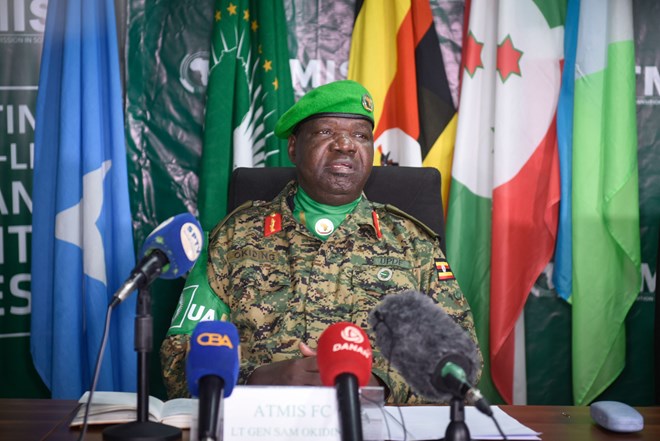
The African Union Transition Mission in Somalia (ATMIS) handed over nine military bases to the Somali government, marking the completion of the second phase of the troop withdrawal from the country.
“The drawdown of 3,000 troops, and handover of the seven military bases which conclude Bio Cadale, Raga Ceel, Parliament, State House, Qorillow, Burahache, and Kismayo Old Airport ENDF mark a watershed moment in the ongoing Somalia security transition process,” ATMIS said in a statement.
Speaking during the official handover ceremony, African Union Commission official, Alhaji Sarjoh Bah, said the drawdown marked a significant milestone in Somalia’s positive trajectory.
According to Bah, Somalia’s security forces have demonstrated incredible courage and resilience in degrading al-Shabaab as part of sustaining security sector development.
“Our collective efforts have enabled us to carry out an orderly and smooth transition of 2,000 troops last year and, this month 3,000 ATMIS troops through the handing over of seven key forward operating bases.
The African Union wants to start the phase 3 drawdown of 4,000 additional ATMIS troops by June 30.
Established in 2007, the AU Transition Mission in Somalia (ATMIS), previously known as the AU Mission in Somalia (AMISOM), gradually drew an estimated 22,000 troops from Uganda, Burundi and neighbouring Kenya, Ethiopia and Djibouti.
The AU peacekeeping forces aimed to assist Somalia’s federal government in its conflict against al-Shabab.
When peacekeepers were first deployed, the al-Qaeda-linked armed group controlled nearly all territories in south-central Somalia.
Working with Somali security forces, the AU soldiers pushed the fighters into rural areas, which currently, are under al-Shabab control.
(Story compiled with assistance from Xinhua News Agency)
Red Sea tensions may help revive Somali piracy
Red Sea tensions may help revive Somali piracy

Source: The Maritime Executive, Thursday February 1, 2024
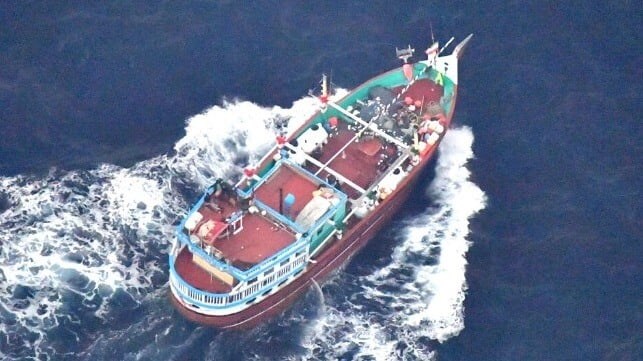
The hijacked fishing dhow Al Meraj-1 (Indian Navy)
Maritime security analysts are concerned that the disruption in the Red Sea and Gulf of Aden may be creating new opportunities for Somali pirates, who had been quasi-dormant since 2012 but have recently picked up the pace.
EUNAVFOR assesses that there are at least two pirate action groups now operating in the Eastern Indian Ocean, and they may be equipped with mother ships (hijacked dhows) to increase their range. This aligns with a substantial uptick in pirate activity: Neptune P2P, a piracy consultancy, counts 16 incidents (of varying severity) since late November.
The first sign of trouble came on Nov. 22, when Somali pirates hijacked the Iranian fishing vessel Al Miraj 1 off the coast of Puntland. Neptune’s local sources reported that the vessel had been stolen by a local gang for duty as a pirate mothership. This working method was used often during the peak years of Somali piracy.
On January 4, suspected Somali pirates boarded and attempted to hijack the bulker Lila Norfolk off Eyl, Somalia. The attack was unsuccessful and the assailants fled.
Multiple smaller fishing vessels have been hijacked over the course of the month (seven more, by Neptune’s count); at least three have been rescued by the Indian Navy.
At the same time that pirate action groups have been gearing up again, the foreign naval forces that have protected shipping against Somali piracy have had a portion of their capacity diverted to deal with Yemen’s Houthi rebels, who have repeatedly attacked shipping in the Red Sea and Gulf of Aden. It is likely that Somali criminals see a window of opportunity for piracy now that the Houthis are creating a distraction, according to Neptune.
At the same time, the Houthis’ attacks have made the Red Sea less attractive, and have forced hundreds more ships to take the route around the Cape of Good Hope. Depending on the point of departure, the route around the Cape can include a transit through waters nearer to Somalia. “This presents a significant increase in the number of ‘targets’ for pirates to exploit, especially vessels transiting to and from the Persian Gulf,” assessed Neptune P2P.
Dr. Ian Ralby, of maritime security consultancy IR Consilium, agrees that the ship diversions also come with a risk of exposure to Somali piracy – and that the pirate action groups have been keeping ready.
“[Somali] skills for piracy were not lost over the last decade, they were transferred. A lot of the attacks by Somali pirates were against vessels that were engaged in illicit trafficking. The reporting just hasn’t been there,” he said in testimony in Congress this week.
Italy’s Meloni opens Africa summit to unveil plan to boost development and curb migration
The European Council has adopted sanctions against six entities involved in the war in Sudan. The horn of Africa nation’s regular army (SAF) and the paramilitary Rapid Support Forces (RSF) have been fighting since last April.
Source: 23 January 2024, The European Council has adopted sanctions against six entities involved in the war in Sudan. The horn of Africa nation’s regular army (SAF) and the paramilitary Rapid Support Forces (RSF) have been fighting since last April.
The Council said in a statement Monday that the six entities were responsible for “supporting activities undermining the stability and political transition of Sudan”.
Among those listed are two companies involved in the manufacture of weapons and vehicles for the SAF (Defense Industries System and SMT Engineering).
The bloodshed in Sudan has continued to escalate despite international attempts to forge a lasting ceasefire. The war has uprooted more than 7.5 million people from their homes and created a humanitarian crisis.
In November, the European Union condemned an escalation of violence in Sudan’s Darfur region, warning of the danger of another genocide after conflict there between 2003-08 killed some 300,000 people and displaced more than two million.
India’s navy rescues second Iranian-flagged fishing boat hijacked by Somali pirates
India’s navy rescues second Iranian-flagged fishing boat hijacked by Somali pirates

Source: AP, Tuesday January 30, 2024
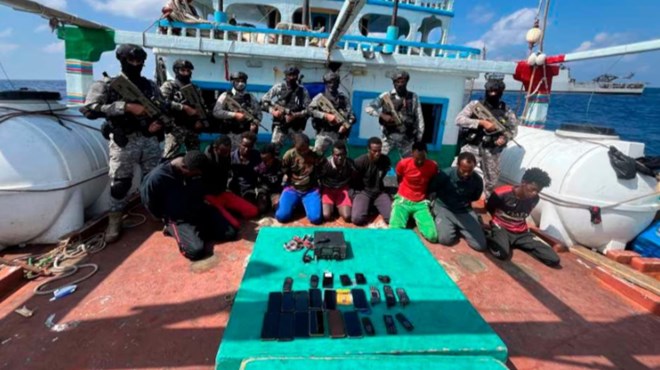
This photograph provided by the Indian Navy shows armed naval commandos standing behind 10 captured Somali pirates with their hands tied behind after they thwarted a piracy attempt on the Iranian flagged fishing vessel Al Naeemi off the east coast of Somalia, Monday, Jan.29, 2024. According to a navy statement Tuesday, Indian naval ship Sumitra intercepted the vessel and freed its 19-member Pakistani crew. The navy did not immediately say what had happened to the pirates. (Indian Navy via AP)
NEW DELHI — India’s naval forces rescued an Iranian-flagged fishing vessel hijacked by Somali pirates and freed its 19-member Pakistani crew off the east coast of Somalia, a navy statement said Tuesday.
The rescue operation was the third this week involving Somali pirates and came a day after India’s forces freed another Iranian fishing vessel named Iman and its 17 crew members from Somali pirates in the same waters. On Saturday, the Seychelles’ defense forces and coast guard rescued six Sri Lankan fishermen whose vessel had been hijacked by Somali pirates.
The Indian navy’s latest operation rescued the Iranian vessel Al Naeemi from the pirates late Monday. The ship intercepted the vessel and forced the pirates to release the crew and boat, which 11 Somali pirates had boarded, the statement said.
The navy did not immediately say what happened to the pirates responsible for the hijacking. But it posted images showing 10 pirates with their hands tied behind them and armed Indian naval troops guarding them. Another image showed some armed pirates on the vessel.
The piracy occurred in international waters about 850 nautical miles (1,570 kilometers) west of the Indian coastal city of Kochi.
Amid disruptions in global shipping due to attacks by Yemen-based Houthi rebels in the Red Sea since November, the Indian navy has ramped up its deployment by sending three guided missile destroyers and reconnaissance aircraft to the vast Indian Ocean.
They have carried out several anti-piracy missions in addition to helping at least four merchant vessels that were attacked in the high waters amid Israel’s war with Hamas.
Somali president discusses Ethiopia-Somaliland conflict with AU chairman in Rome
Somali president discusses Ethiopia-Somaliland conflict with AU chairman in Rome

Source: Hiiraan Online, Tuesday January 30, 2024
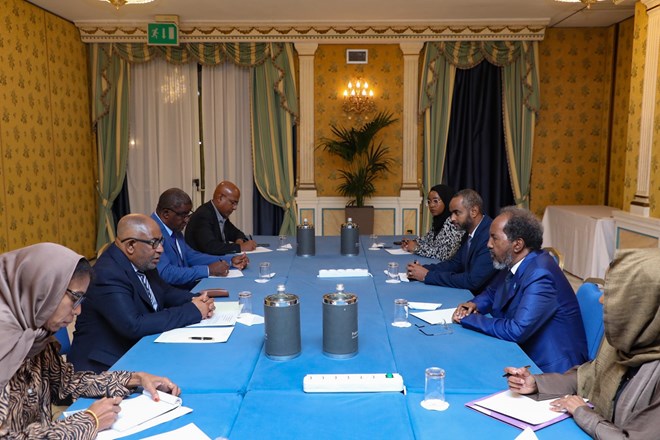
Mogadishu (HOL) – Amidst increasing tensions in the Horn of Africa, Somali President Hassan Sheikh Mohamud met with the African Union Chairman and Comoros President Azali Assoumani at the Italy-Africa Summit in Rome.
The meeting comes in the wake of a controversial Memorandum of Understanding (MoU) signed between Ethiopia and the self-declared autonomous region of Somaliland. The MoU, allowing Ethiopia access to the Red Sea port of Berbera, has raised significant concerns over regional stability and security. Somalia has vehemently opposed this agreement, declaring it null and void, and has recalled its ambassador to Ethiopia. According to sources, Somalia’s firm opposition to the agreement formed the backdrop of this high-level engagement.
In response to the rising tensions, the African Union Peace and Security Council (PSC), at its 1192th meeting on January 17, expressed deep concern. The Council emphasized the importance of respecting the unity, territorial integrity, and sovereignty of all its member states, including Ethiopia and Somalia.
Moussa Faki Mahamat, Chairperson of the African Union Commission, has urged both countries to engage in peaceful negotiations, stressing the need for mutual respect and adherence to the principles of good neighbourliness. This call for dialogue and restraint is seen as vital for maintaining peace and stability in the Horn of Africa.
Ethiopia’s Prosperity Party commits to transforming MoU with Somaliland into ‘practical agreement’
Ethiopia’s Prosperity Party commits to transforming MoU with Somaliland into ‘practical agreement’
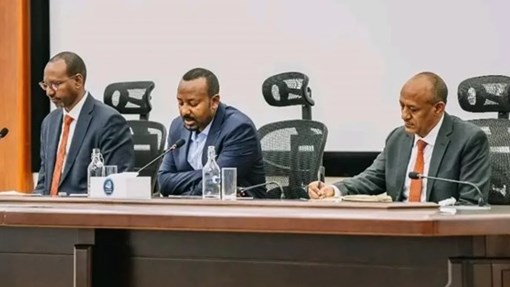
Source: Hiiraan Online, Mogadishu (HOL) – Following a four-day assembly, Ethiopia’s ruling Prosperity Party (PP) has vowed to advance its contentious Memorandum of Understanding (MoU) with Somaliland into a “practical agreement.” This commitment, made by the party’s Executive and Central Committee members, has sparked significant regional tension, particularly with Somalia.
UAE Is Major Player in Horn of Africa
UAE Is Major Player in Horn of Africa
Source: World Politics Review published on 23 January 2024 an analysis titled “The UAE Has Become a Major Player in East Africa. That’s a Problem” by Jonathan Fenton-Harvey.
The UAE is promoting “authoritarian stability” in the Horn of Africa by investing widely and supporting movements such as the paramilitary Rapid Support Forces in Sudan. It also provided drones to the Ethiopian government in its battle against Tigray Region.

